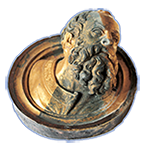Modern scientific methods have led to a wealth of information in archaeology, cultural heritage research, and art conservation concerning the composition of artefacts both on a molecular level and on the mechanical built of objects that can not be dismantled without destroying them. X-ray methods from radiography to fluorescence have become widespread, but also neutron methods gain increasing interest. Due to the non-destructive nature of neutrons they have been developed to an invaluable tool in analysing precious archaeological objects.
Neutrons can penetrate deep into the cultural artefact or beneath the surface of paintings to unveil structures at the microscopic scale and thus determine the chemical composition, provide 3D images of the inner parts of the artefacts, and reveal organic material like wood, leather or bones in sealed metal or stone containers. Whole artefacts can be placed in the neutron beam and analysed at room conditions, without sample preparation. Measurements are made in real time, which can be useful for testing conservation materials and methods.
Two- and three-dimensional imaging provides visual information, while neutron activation analysis delivers elemental composition information, and neutron scattering reveals alloys and textures. Thanks to modern detectors, neutron imaging can even be performed at low-power research reactors, which allows the application for cultural heritage research also at small research reactors throughout the world.
The MLZ Conference Neutrons for Culture and Arts addresses archaeologists and conservators from museums and universities and aims to illustrate the potential of neutron methods in cultural heritage research. Talks and posters will be presented by renowned international researchers, physicists, and archaeologists in the field to demonstrate state-of-the-art methods and applications.
Topics
- Archaeometry
- Ceramics
- Textiles
- Numismatics
- Paintings and provenance
- Statuettes and figurines
- Wood and soil
- Fossils
- Ancient technologies
- Non-destructive characterisation with neutrons
- Neutron Radiography and tomography
- Neutron activation analysis
- Prompt gamma activation analysis
- Bragg edge scanning, phase gratings, texture
- Scattering and diffraction methods
- Others
Keynote speakers
- Jacopo Corsi, Università degli studi di Tornio, Italy
- Anna Fedrigo, ISIS, United Kingdom
- Francesco Grazzi, Consiglio Nazionale delle Ricerche, Italy
- Martina Griesser, Kunsthistorisches Museum Wien, Austria
- David Mannes, Paul Scherrer Institut, Switzerland
- Ina Reiche, Rathgen Forschungslabor, Germany
- Roberto Senesi, Università degli Studi di Roma Tor Vergata, Italy
- László Szentmiklósi, Hungarian Academy of Sciences, Hungary
- Alan Williams, The Wallace Collection, United Kingdom

